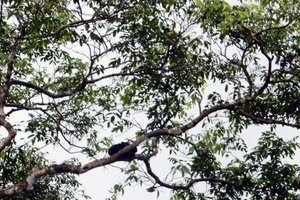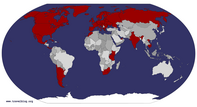Advertisement
Published: October 13th 2017

 Howler sleeping
Howler sleeping
Balls of fur balanced on a branchWow! What a rainforest day!
Rain was falling in the night the few times I woke. Getting ready for breakfast, I couldn’t tell if it was actually raining or if the trees were dripping loudly on the tin roof. The latter.
Today’s excursion was in a small open boat to look for animals and birds. Right by the hotel were a couple of
Howler Monkeys sleeping high in a tree; they looked like bundles of fur, in Ollie’s words. We moved at speed down the river past the town, and then slowed to look around. I liked how a wide, long mat of graceful grasses bobbed even in the quiet wake of the boat as we looked up at the immensely tall trees. The mass of trees and bushes and grasses is known as a “gallery forest”.
Of course, Ollie and our boatman Adrian sighted most of the wildlife, although Judi was quite good. We saw the flicker of a Howler as it moved across the canopy, silhouetted momentarily against the white cloud sky. Down near the water in a couple of places were
Green Basilik Iguanas, immobile during our portraits of them. These two were a bit bigger than a hand;

 Tortuguero National Park
Tortuguero National Park
Quiet drift into mysterious canalslater we saw two much larger brown iguanas, almost invisible against the trunk of a broken tree. With our cameras we “chased” a couple of
toucans, recognizable only because they were identified to us.
Quite suddenly it began to rain in earnest – we had ignored the light rain that had earlier anointed our venture. We quickly donned the heavy ponchos supplied, and Adrian drove fast from where we had been so gently enjoying the rainforest. Ollie had instilled in us yesterday that rain is nothing extraordinary in the rainforest; he quoted Bob Marley, “You just get wet.” We turned down a canal - I relaxed and enjoyed the vision of the water droplets popping on the water amongst the soaring plants. Ollie persisted because he wanted to show us a research station displaying the Costa Rican and Canadian flags, a joint project. Since we are all Canadians, he quite often mentioned the beneficial links between our two countries. Just as we were to turn around, Adrian pointed out a
Cayman sheltering at the shallow edge, about a metre long, although we could only see its head and shoulders.
About this time I discovered that my poncho had

 Caño Palma Biological Station
Caño Palma Biological Station
Canadian - Costa Rican research station since 1991been draining onto the seat next to me where my backpack was soaking up the water. My little notebook was under the backpack, to keep it safe, and it dropped into the water at the bottom of the boat as I snatched up the backpack. The notebook was dripping, although the ink didn’t dissolve – nothing lost. In fact, by the end of our excursion everything was either soaked or damp, including all the clothes we were wearing.
(3:27 p.m. The Howler Monkeys are howling just now, as they also did at about 4:30 a.m. The sound is like a hoarse pack of dogs baying while someone in the sky moves heavy furniture.)
Our next stop was the
Tortuguero Sea Turtle Conservancy station, where we moderately dried off as we learned about the important role of the National Park. Mary, the current resident scientist, described the work of the Conservancy, established in the 1950s by an American. His concept and the realization was that the local people could become engaged with scientists to preserve the turtles rather than eat them as their primary source of protein. A video told us that the success has meant a 500-fold increase in the turtle

 Tortuguero Beach
Tortuguero Beach
We just missed the turtle nesting season.population. Mary explained that jaguars do prey on the turtles, but since they are both endangered species, nature has its way; jaguars kill only two percent of the female adult turtles. During the egg laying season from June to October, scientists and some volunteers do four-hour shifts from midnight until after dawn observing the nesting, taking measurements, tagging and even erasing turtle flipper marks to minimize chances of predation. Once the nests are virtually empty, they also study them to learn what might have prevented some eggs from hatching. For example, twins and albinism are usually fatal.
When I asked Mary how she had chosen this field for her career, she came alive with excitement. In Grade One she had won a reading contest by reading one thousand books, many of which were scientific (not just children’s books!). In an American Girl magazine she read about a girl who rescued turtles, and she announced to her parents that she would do that when she retired, not knowing it could be a career. She designed her own degree, taking courses in countries around the world where there were turtle preservation centres. This amazing woman infused us with her

 Tortuguero Village
Tortuguero Village
Quiet life behind the quiet tourist streetpassion.
We walked down to the turtle beach, and I was startled at how far the turtles come seeking the shelter of the
Seaside Grape bushes – perhaps 200 feet or more. The rain was slowly lifting, and the sand was warm and soft on my sandaled feet. The surf was heavy, beautiful against the dark grey sand and the dark blue clouds. We strolled along, one amongst a few groups of tourists. Mary had told us that any garbage we might see would have come from the sea, because the whole community is invested in recycling and does not litter. Volunteers pick up the garbage that comes to the land, so the sand was perfectly clean. (Young turtles in the sea can starve to death from eating plastic, thinking they are full of food when their stomachs are actually half full of indigestible plastic.)
At Tortugera Village, we walked inland through the residential area. Although the boulevard we saw yesterday along the riverfront is where the tourists shop, the village “streets” are more like paths, because of course there are no vehicles in the village or the Park. Bicycles carry the goods and supplies from the boats to
their destinations. The houses are similar to those I saw in Antigua, rectangular, with one corner or side cut out as a porch or veranda. Many have attractive front yards, some bordered with hedges of colourful yellow croton – another thing that is a house plant at home and a bush here. As we passed a fruit and vegetable stand, I joked with Ollie that I would have to buy some bananas, because we haven’t been served any yet and I had looked forward to the local produce. He took me up on it, and bought half a dozen, a welcome treat to assuage our growing hunger pangs.
Adrian came to fetch us in a dry boat, and we eagerly went in to lunch. I had pork stew with steamed vegetables (including a third type of squash) and rice garnished with pepper sauce and Costa Rica’s well-known
Lizano salsa. After lunch I indulged in a nap and wrote notes.
In the late afternoon, Ollie offered to conduct a tour of the gardens. The others had already walked around on their own, so I got a private tour. Before meeting me, he had checked out where frogs might be, and
he led me right to the habitat of a
Red Eyed Tree Frog, the little star of Costa Rica tourist ads. About two inches long, it has bright green skin and intense red eyes. Really it preferred to have its eyes shut but opened up whenever Ollie touched him. At one point, the frog was so annoyed he jumped off a broad leaf and landed on Ollie’s head! Probably confused, it manoeuvred around and then leapt firmly into the greenery. About in the same place, Ollie and a couple of maintenance guys searched for the
Red Poisonous Dart Frog. I took pictures of where they were pointing in the hope that something would turn up in focus. For a microsecond I saw it springing away, leaving me with only the impression of what it was.
We walked further along the stone pathway, while I admired the flowers – red and white ginger, rusty-red heliconia, and delicate purple orchids. A huge bush spread in front of a cabin, yet it looked like a common houseplant, long leaves with yellow stripes – I will have to check it. (Google says it is a houseplant.) As we walked further into the darkening rainforest, Ollie spotted a troupe of
Spider Monkeys high in the canopy. At first I only saw the motion of the trees, but eventually as two moved onto a branch more in the light, I was able to actually see them. We ventured onto a hanging bridge that spanned a particularly wet part of the forest floor. Here we were fully in the textured rainforest, listening to the rising vocalizations of frogs and toads - a benign assault on our ears and consciousness.
Dinner: thick vegetable soup, pan-fried tilapia with tangy tartare sauce, steamed vegetables, rice with spicy sauce and salsa, Imperial beer
Advertisement
Tot: 0.11s; Tpl: 0.014s; cc: 13; qc: 32; dbt: 0.0495s; 1; m:domysql w:travelblog (10.17.0.13); sld: 1;
; mem: 1.2mb































Isabel Gibson
non-member comment
Great shots of wildlife
What a day! Judging by your photos, you had some great sightings of wildlife. I never saw the frogs, so maybe I'll have to go back! Our guide called your toucan the Sammy Fruit Loops toucan from the illustration on the cereal box. I forget its scientific name, but remember that. :-)